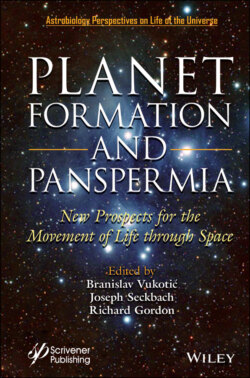Читать книгу Planet Formation and Panspermia - Группа авторов - Страница 33
4.2.2 Galaxies: Cosmic Cradles of Life
ОглавлениеSimilar to [4.8], the following formalism is usually used to estimate the stellar collision cross-section [4.23]:
(4.1)
where the right-hand side variables are stellar density, velocity, and collision cross-section, respectively. Following the simulations from [4.20], the author uses <σ> = 100 AU2, as the average value for the collisions that have a disruptive potential for terrestrial planets. We can consider it likely that an order of magnitude larger values, for a collision distance (parameter), of b = 100 AU ≈ 5 × 10−4pc, would be sufficient to disturb the small bodies of the target stellar system, consequently scattering some of them into interstellar space. This relates to the small bodies that are relatively close to the inner terrestrial planets, such as the asteroid belt in the Solar system. However, such objects can be found more loosely bound and in much larger numbers in the outer Solar system. Given that the Oort Cloud could stretch as far as 105 AU [4.27], a nearby stellar passage at even 0.5 pc, could send swarms of icy and rocky objects into interstellar travel. However, these more distant objects are likely to be the pristine remnants from the stellar system formation, and less likely to have contact with the inner parts of a stellar system, where complex biochemistry could take place and aggregate the organics, originating from molecular clouds, into actual living forms.
The existence of such an extensive structure of small objects around the Solar system would imply that our Earth did not suffer much from flyby perturbations throughout its history. The dynamically unexcited Kuiper belt implies that the Solar system did not have encounters with other stars within 240 AU [4.6] in its birth cluster as well as in its current galactic environment. An estimate of the collision parameter value that is most effective in terms of ejecting the panspermia material is likely to be a matter of fine tuning. However, a caution should be made here, since a radically different (unknown) form of life (e.g., Dyson’s “cometary trees” or Lem’s cloud of Y-shaped microscopic components) might be preferentially propagated by different kind of ejection events, with different ejection parameters, creating a kind of natural selection between these different “panspermias”.
Encounters within 100 AU can capture or eject a Neptune from its orbit [4.22], which would be captured by the star flying-by in 1 in 12 encounters. The planets around binary or multiple stars appear to be more vulnerable to stellar flybys [4.19]. While planets hosted by a single star have a significant probability of being disturbed only in longed-live stellar clusters, the ones having a binary host are much less stable. No wonder then we have found ourselves orbiting a single star. Although binary systems are more numerous than single star planetary systems, they offer less stable habitability conditions since the orbits of their planets are more frequently perturbed, when compared to single stars for a fixed value of the collision parameter.
The material ejected from binary systems should, then, on average, have less evolved living matter. The more potent panspermia material should be expected to originate from single star planetary systems that had flybys as close as ~102 AU. Flybys at ~103 AU are likely to scatter around only the debris of small bodies that did not change their biological complexity much since the formation of the given stellar system. This might still be important for the overall astrobiological landscape, depending on the timescales involved. Even if it consists just of prebiotic complex chemicals, it might delineate the part of the GHZ containing a set of biospheres of a particular kind.
Capture time scales and collision cross-sections for single and multiple stellar systems are considered in [4.1, 4.5, 4.9, 4.14, 4.23]. They demonstrate the possibility that stellar systems can eject material during their evolution or as a consequence of stellar flybys. This should populate the galaxy with rogue planets and other debris as a result of these ejections. However, it has been argued that interstellar panspermia would not be viable, except as a rare occurrence between closely neighboring stars [4.10]. For panspermia in stellar clusters, low estimates have been made, but still deemed viable [4.2]. They also calculated that in a cluster of 100 stars, life seeded from the outside could spread within the cluster in a matter of 10 Myr.
Over long-time scales, galaxies should have increasing amounts of “living” material spread across them, if it is sufficiently resistant to everpresent radiation hazards. While the flyby induced ejections from “mature” planetary systems can offer better panspermia prospects, it is a nonnegligible probability of planets that are ejected by giant planets from the same stellar system at early stages of planetary system evolution. Six such planets are estimated to be recaptured at the Solar galactocentric distance within ~ 200 Myr [4.12]. This result is obtained based on the assumed present epoch stellar density at the present Solar galactocentric distance.
